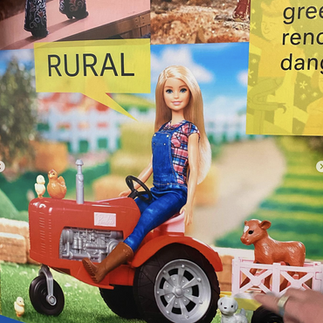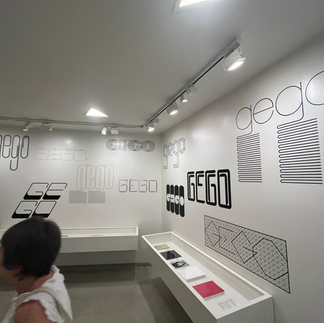Goo-Goo Gaga Guggenheim
- Lana N Scibona
- Jul 22, 2023
- 3 min read
The last time I went to the Guggenheim was also the first; admittedly I only held off so long because the $25 admission always felt like a splurge in comparison to other museums’ pay-what-you-want model. I went there on an extremely cold day with a friend I don’t talk to anymore, in a sweater I’ve since lost. The current exhibit then was Countryside, the Future, an elementary comparison of country and city lifestyles that read like an academic paper and didn’t honor the spectacular feat of the museum itself. While I’m sure a ton of research went into this project, the visual elements fell flat. A solid portion of the exhibit was text, which is hard to digest as small print on a wall. Poorly printed curtains covered the areas where art usually hangs and the pillars were decorated with pop culture images and objects including a glued-on LEGO set. I took a selfie with a life-size cut-out of Stalin.
Sunday July 3rd, however, I set out to return. It was a sweltering day and I welcomed the blast of cool air in the lobby. My main focus was Young Picasso in Paris. Though small, I was impressed. I have high standards for new information about him as it feels easy to regurgitate the typical stories. As a contribution to the world’s commemoration of Picasso Celebration: 1973-2023 it was solid and unique in its exploration of the artist’s first years in Paris. There were also some contextual insights I appreciated, like grounding us in the racially charged exhibits at the Paris World’s Fair and the gender ambiguity of Parisian nightlife. These elements of history are often erased or lumped into a general “Picasso was a bad dude” storyline. Here, though, curator Megan Fontanella illuminates this overlooked history in the City of Lights and allows visitors to join the conversation. Especially when considered in the larger scope of the Picasso Celebration exhibit circuit, these nuanced reflections do a great service in making such a notorious figure relevant to our times.

Despite my praise for the Picasso exhibit, the day’s delights were found in the main rotunda. First up was “Gego: Measuring Infinity,” a comprehensive retrospective on Gertrud Goldschmidt or “Gego” as she renamed herself.

The engineer-turned-artist built a dynamic career on meditatively-built shapes that cause us to question the very fabric of reality. Escaping European anti-Semitism at the dawn of World War II, her arrival in Venezuela coincided with a boom in Latin American modernism. Her two- and three-dimensional studies in depth, shape, perspective, and order rival the preparatory sketches of Renaissance masters, as though we are perceiving the sinuous lines upholding our world for the first time.
The simplicity with which she assembled her floating sculptures, etchings, graphic signatures, and woven textiles is the definition of purposeful. These distortions are utterly delicate, as though a god-like finger gently pressed on the structure and caused the most subtle ripple, just enough to notice a momentary shift. Co-curated by Pablo León de la Barra and Geaninne Gutiérrez-Guimarães, this selection of 200 masterful works is moving enough for even the most skeptical “I could do that” critic to be set adrift on a philosophical cloud.
As I ascended further into the building seashell swirls, I encountered another marvelous mind-fuck in the form of “Sarah Sze: Timelapse.” Where Gego questions shape, Sze dives into the physicality of time. Her site-specific insulations turn the idea of collage into sculpture with combinations of items you might find in a junk drawer. This is clutter beyond a fabricated, inauthentic quirk. We’ve passed through the dimension of what should be and have arrived at what is.

Encountering Sze’s explosive sensibility gave me the thrill of finding treasure, sneaking behind a curtain to find a surprise, breaking all the rules. A sense of awe with a dash of curiosity was palpable among my fellow museum-goers. It was almost as though these works were unfinished and evolving on their own like abandoned buildings reclaimed by nature. As light, shadow, and sound sprinkled themselves throughout, it becomes clear why we were all so dazzled. Each glimpse of Sze’s creations can only exist in that precious moment. Forever creating and recreating itself, the creation of art is the art.

The combination of these two female powerhouses was outstanding. Each provided complementary elements not only to each other but to the entire Guggenheim structure itself, telling a single story in multiple parts.







































Comments